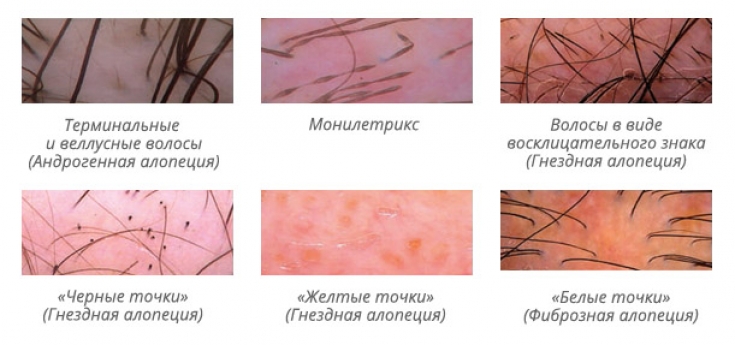Hair loss – a very common complaint. Patients may describe both diffuse hair loss and local hair loss. Differential diagnosis of hair pathology, at first glance, does not cause problems, however, very often a hastily diagnosed diagnosis turns out to be false.
The best assistant for a doctor in diagnosing the cause of hair loss is trichoscopy, which can clearly identify the signs of a particular disease.
At estet-portal.com read about the main criteria that will help distinguish alopecia areata from fungal hair loss, scarring alopecia, discoid lupus erythematosus, etc.
Effective methods for diagnosing hair loss
There are many methods for diagnosing the causes of hair loss.
They can be divided into:
• invasive(biopsy);
• minimally invasive (trichogram);
• non-invasive (microscopy, trichoscopy).
Each of these methods, in combination with clinical examination data, allows obtaining sufficiently accurate information regarding the diagnosis, and also makes it possible to track the patient's condition over time.
Trichoscopy of the scalp helps to detect signs of a certain type of hair loss, which is especially important in the early stages of the disease, when the clinical picture is not yet sufficiently pronounced.
Trichoscopy makes it possible to make a correct diagnosis from the first visit, which allows you to prescribe the necessary treatment as soon as possible.
What methods will help to quickly and effectively diagnose microsporia
The main causes of diffuse and patchy hair loss
Let's dwell on the main diseases that lead to hair loss:
• Trichotillomania — compulsive hair-pulling. Usually combined with other symptoms of an obsessive-compulsive nature: nail biting & nbsp; etc;
• Microsporia — fungal infection of the hair. Most often occurs in children, and is combined with an increase in lymph nodes;
• Diffuse telogen effluvium. Most often occurs as a result of severe stress (fever, surgery, moving), within 3 months after exposure to a provoking factor.
• Scarring alopecia occurs as a result of trauma to the skin, and as a result — deficiency of follicles in the affected area;
• Alopecia areata — multifactorial autoimmune disease;
• Androgenetic Alopecia — hair loss due to excessive exposure of the follicle to male sex hormones.
All these diseases have different etiology, and therefore the approaches to their treatment are radically different. Therefore, the correct diagnosis is the key to success in the treatment of hair loss.

Alopecia: main features of differential diagnosis
Trichoscopy — is one of the simplest and most effective diagnostic methods in trichology. This is due to the fact that almost any hair pathology has its own special trichoscopic picture.
Trichotillomania: broken hairs of varying lengths that rise above the surface of the skin, black dots, clearly defined orifices of hair follicles;
Microsporia: hair &ldquo ;as a comma” and “corkscrew-shaped”, broken hair shafts, signs of peeling and inflammation, spores and mycelium of the fungus are detected by microscopy; empty hair follicles over the entire surface of the skin without reference to a specific area;
Scarring alopecia:manifestations of atrophy, empty follicle orifices;
Alopecia areata: Broken hair, "exclamation point" hair, "yellow dots" and «black dots»;
Androgenetic alopecia: pronounced hair polymorphism with an increase in the number of fine hairs, empty follicles.
raquo;, "yellow dots" and «black dots»;
Androgenetic alopecia:
raquo;, "yellow dots" and «black dots»;Androgenetic alopecia: pronounced hair polymorphism with an increase in the number of fine hairs, empty follicles.
Alopecia areata: causes and treatment
Trichoscopy is the best diagnostic method even in cases where the patient has several diseases at once. Unlike a biopsy, which has the maximum information content, trichoscopy is a simpler method that allows you to work with large areas of skin at once, which greatly speeds up the diagnosis.






Add a comment